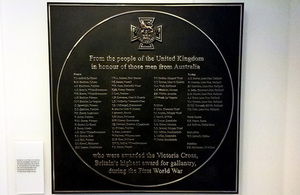Paving stone laid for knockout Australian hero
Cpl Wally Brown among 52 Australian-born winners of the Victoria Cross during WW1 honoured yesterday by Prime Minister David Cameron.

The plaque commemorating Australia's WW1 VC winners on display at the Australian War Memorial, Canberra.
A memorial paving stone was laid yesterday at the National Memorial Arboretum in Staffordshire in honour of Walter “Wally” Brown, an Australian hero awarded the Victoria Cross (VC) during the First World War.
The paving stone has been laid alongside 144 others to recognise all overseas born First World War VC recipients as part of the UK Government’s First World War Centenary commemorations.
Walter Brown was awarded a Victoria Cross, Britain’s highest military award, for his actions on the 6 July 1918 at Villers-Bretonneux, France. Brown, on hearing that a sniper’s post was causing significant trouble, ran towards an enemy’s location with two mills bombs.
As he approached, under heavy fire, his threw his first bomb which fell short, but on reaching the enemy he delivered a knockout punch to the German that rushed him and threatened the others with the remaining Mills bomb. The Germans, one officer and twelve men of 137th Infantry Regiment, surrendered and Brown shepherded them back to the Australian lines.
Communities Minister Lord (Tariq) Ahmad of Wimbledon said:
The First World War was a truly global war, and one which pulled in people from every corner of the earth. People from every background united in their shared values.
Walter Brown displayed exceptional bravery, as well as a mean right hook, which not only saved the lives of his friends around him – but also his foes.
The stone that will lay in the National Memorial Arboretum for Walter is a small token of our gratitude. I hope that for many years to come it will remind us all of the gallantry of the brave men who fought for Britain and their role in the history of the First World War.
In August 2013 Communities Secretary Eric Pickles announced a nationwide campaign to honour those who received the VC, Britain’s highest military honour, during the First World War. As part of this, over the next 4 years on the date corresponding to when they were awarded the VC, commemorative paving stones will be laid in their place of birth or where they lived following the war.
469 stones will be laid in communities in England, Wales, Scotland and Northern Ireland. 35 VC recipients will be commemorated in the Republic of Ireland.
However, the British War effort was made up of people from every corner of the globe and 145 VCs were awarded to those born overseas.
These heroes will be commemorated by the unveiling of 145 stones at the National Memorial Arboretum on 5 March.
During his visit to Australia in November 2014, Prime Minister David Cameron, on behalf of the people of the UK, presented a bronze plaque bearing the names of all the Australians awarded the VC during the First World War to the Australian War Memorial in Canberra. The plaque is on display in the Memorial’s newly re-opened First World War Galleries.
Biography
Walter Earnest Brown was born on 3 July 1885 in New Norfolk, Tasmania. A grocer, he enlisted in the Australian Imperial Force in July 1915. Following the war he was repatriated to Australia in 1919 before being discharged in 1920. He married Maude Dillon and had two children.
Following the outbreak of the Second World War, Brown lied about his age and his military experience to be able to serve despite being overage. He was killed in action in Singapore in February 1942.
Further information
52 Servicemen born in Australia were awarded the Victoria Cross during the First World War.
The first Victoria Cross Paving stones were laid on 23 August 2014 to mark exactly 100 years to the day that the first Victoria Crosses were awarded during the First World War. The last stones will be laid in November 2018. A public competition was held to choose a design for the paving stones and this was judged by a panel of 7 experts. The competition was won by Charlie MacKeith from London whose winning design will feature on all the paving stones that will be laid in communities across the country. The circular design seeks to ‘make one pause and remember’ and uses the material, form and lettering of the family of memorials used by the War Graves Commission.
The paving stones are made of Scoutmoor Yorkstone a hard-wearing British stone that is quarried near Ramsbottom. Each stone will include the name of the individual, the rank and regiment of the individual (at the time the VC was awarded) and the date of the action for which the VC was awarded.
You can follow the laying of the commemorative stones on Twitter #VCpavingstones, and on Pinterest.